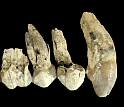|

Press Release 06-065
New Fossils Link "Ape-men" to More Primitive Ancestors

Scientists say discovery "closes the gap"
April 13, 2006
A team of scientists working in an eastern Ethiopian desert has discovered fossil bones and teeth from individuals they believe link the genus Australopithecus--precursors of humans--to a decidedly more ape-like animal of the genus Ardipithicus. Because the fossils were found in areas known to contain evidence of both older and younger specimens, the scientists say evidence of when the three hominid types existed will provide valuable information about human evolution.
Still, 'it is fair to say that some species of Ardipithicus gave rise to Australopithecus," said Tim White, a professor of integrative biology at the University of California-Berkeley and one of the team leaders.
White and coworkers from 17 countries have published their findings in the April 13 issue of the journal Nature.
The fossils are from the most-primitive Australopithecus species, known as Au. anamensis, dating from about 4.1 million years ago, said White, and push the species closer in time to its last known ancestor. "This new discovery closes the gap between the fully blown Australopithecines and earlier forms we call Ardipithecus," White said. "We now know where Australopithecus came from before 4 million years ago."
Even though the two are separated by only 300,000 years, Au. anamensis could have rapidly evolved from Ardipithecus. Or, fossils placing the two hominid types on Earth at the same time may yet be found. Nevertheless, White said, the new fossils show clear descent from the genus Ardipithecus, two species of which have been identified over the genus's 2 million years of existence.
Finding fossils of Ar. ramidus, Au. anamensis and Au. afarensis--the oldest known Australopithecine prior to this finding--in successive sediment layers in the same area also indicates an evolutionary sequence, said White.
The National Science Foundation funded portions of the research through its physical anthropology program.
See more about the find at the UC Berkeley Web site.
-NSF-

Media Contacts
Bob Sanders, UC-Berkeley (510) 643-6998 rsanders@berkeley.edu
Leslie Fink, National Science Foundation 703-292-5395 lfink@nsf.gov
Program Contacts
Trudy Turner, National Science Foundation 703-292-7321 tturner@nsf.gov
Related Websites
Berkeley Human Evolution Research Center: http://herc.berkeley.edu/asaissie.php
NSF Awards to Tim White: http://www.nsf.gov/awardsearch/showAward.do?AwardNumber=9910344

The National Science Foundation (NSF) is an independent federal agency that
supports fundamental research and education across all fields of science and
engineering, with an annual budget of $6.06 billion. NSF funds reach all 50
states through grants to over 1,900 universities and institutions. Each year,
NSF receives about 45,000 competitive requests for funding, and makes over
11,500 new funding awards. NSF also awards over $400 million in
professional and service contracts yearly.
 Get News Updates by Email Get News Updates by Email
Useful NSF Web Sites:
NSF Home Page: http://www.nsf.gov
NSF News: http://www.nsf.gov/news/
For the News Media: http://www.nsf.gov/news/newsroom.jsp
Science and Engineering Statistics: http://www.nsf.gov/statistics/
Awards Searches: http://www.nsf.gov/awardsearch/
| 



